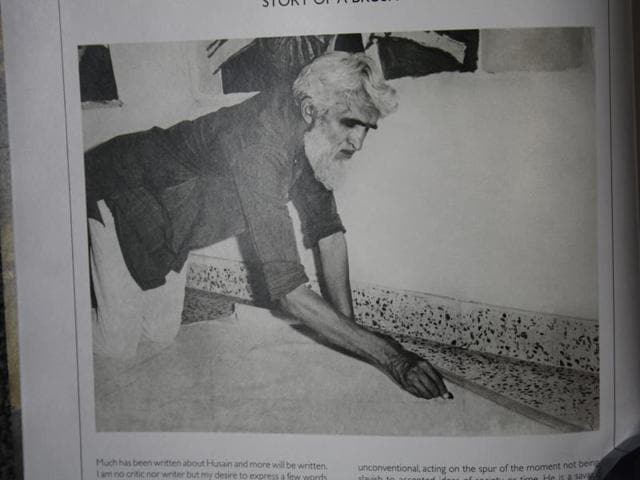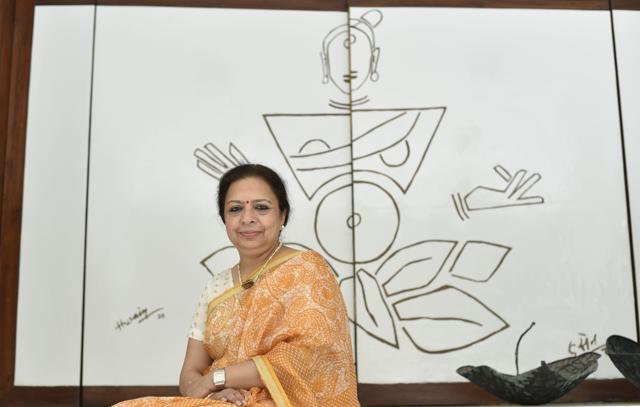Playing to the gallery: Collectors trace the Husain phenomenon
The art world is about big money. As MF Husain’s centenary celebrations draws to a close, collectors trace Husain phenomenon.
Maqbool Fida Husain walked into Pundole’s one day while Kali Pundole, the gallery owner, was up on a ladder trying to fix his lights.

And they struck up a conversation that Kali’s son, Dadiba, has been continuing for more than 60 years. “What set Husain apart from other artists of his time was a huge appetite for risk,” says Dadiba, who, since 2014, has also been running an auction-house, in addition to the art gallery.
“Gaitonde and Tyeb Mehta were contemplative, the painting stayed in their heads for a long time before it manifested itself onto a canvas. Husain had a slightly different working method. He sketched incessantly with his characteristic strong lines. His thoughts poured out onto whatever medium he had closest to him,” adds Pundole’s auctioneer Mallika Advani.
If the ’80s was the age of marriage between India’s artists and their collectors, it was the ’50s when they began their roaring affair. Their relationship was informal. Contracts were signed but rarely imposed. Works of art were bought and often paid for over long installments.
Watch | M F Husain: A look at the maverick artist’s career
In Bombay, the work of the Progressive Artists’ Group, (PAG was influenced by the Calcutta Group, the first modern art collective of India), consisting of ‘local boys’ Francis Newton Souza, Syed Haider Raza and MF Husain were put up on the walls of local libraries and restaurants.
The art salons, patronised by emigre European collectors who had stayed on in India either by choice, or because they had been caught unawares by World War II, built the art milieu that would go on to develop India’s first art networks. It was this ecosystem that would help sustain the man who was the first Indian artist keen to study the art-market at a time when the other leading lights of the PAG, Souza and Raza, had left for Europe.

“In a large nation like India, once you click in an art market set for globalisation, you need to produce paintings in number and that may eventually lead to repitition,” points out senior artist Ashok Bhowmick, who has written a book on the Husain phenomenon. “For example, Ganesh Pyne would do 10 paintings a year. Husain could do 10,000. He had the signboard painter’s skill to work fast.” Commercial galleries such as Pundole’s and Chemould opened in Bombay in 1963. In Delhi, Kumar Gallery, believed to have presented Husain’s first solo show, opened its doors in 1955.
Private lives
Husain’s rise runs on the tracks of a post-independent nation. In a Nehruvian India, he was a cultural ambassador as much as sitarist Pandit Ravi Shankar. Almost a ‘state artist’, Husain’s reach and visibility were naturally immense. He was part of an artist delegation to draw soldiers fighting the 1965 war against Pakistan.

He was one of the first painters to have his work hung in Delhi’s North Block. With such a profile, if he said he was “no less than Picasso” you had better believe it.
“What he meant when he said that was, that for Indian modern art, his role would be as great,” explains Virendra Kumar, owner of Kumar’s Gallery in Sundernagar, Delhi, and one of his first collectors.

Gallerists could certainly claim to know the artist’s mind. They were privy to artists’ personal lives, their momentary or permanent obsessions. They had to be. They were the artists’ partners in ‘aesthetics’ and their patrons as well. Kumar self-consciously holds up a pink telegram from Husain (‘“Jaisalmer a masterpiece of textual essay in yellow and sand. Send me by wire 400 Rs at the PWD Dak bungalow”) from the early ’60s for funds to stay on in Rajasthan to paint. Such requests were common and were not included in the final price of a painting, says Kumar, who paid Husain Rs 1,800 / month for three medium-sized paintings in the ’50s.
“These were stipends to get the artist by, irrespective of sales,” he adds. By the ’90s, when a medium-sized Husain had reached Rs 3 lakh, Kumar would be paying the artist Rs 2 lakh after deducting the gallery’s commission.

Not everything was for sale though. Husain painted a family portrait of Anil Relia, an Ahmedabad collector, in the 19th century style, a period which he collects, as a gift. “He told me ‘your wife is the nucleus of your family so her portrait must be the most prominent. He placed her on a bench in our garden. He made me sit on the ground, my son next to me and my daughter behind her mother. So, us four plus the family parrot.” One of Relia’s prized paintings is the one he bought from Husain’s biographical series in Renu Modi’s gallery. “It is of Husain on a cycle.”
Delhi’s Arun Vadehra, who introduced the concept of ‘buying art’ rather than pay the artist stipends, thus making a bigger financial commitment to the artist in the 80s, says Husain’s presence in his life was about sudden entries and departures. “He would announce his arrival in the gallery by asking for a canvas, paints, a brush, and we always had them ready…if he wanted to sleep, he did, on the leather sofa in my office…he would call me from London or New York and ask me to come over as if he was in Greater Kailash.”

The give and take between the artist and most of his collectors remained cordial, despite the transactional nature of the relationship. Both needed the other. Badrivisal Pittie, a cultural impresario of Hyderabad and scion of a prominent business family (his collection of Husains fetches top hammer price at most auctions for belonging to the artist’s best period, the ’50s) sponsored Husain’s first trip abroad. It was during a stay in his house that Husain would paint his famous Ramayana series. He is also said to have painted on every surface available – from table-tops, to matchboxes to the family Fiat car, which he plastered with his iconic horses.
Are horses still the top Husain motifs that Husain buyers want? Renu Modi of Gallery Espace, another post-’80s Delhi gallery with a prominent Husain collection, says serious collectors would want his early period. “But there are buyers of all kinds,” she admits. “Some want horses, some don’t want horses, some want only horses….”

A re-evaluation
Did Husain himself privilege his horses over his elephants, his oil paintings over his acrylics, his reds over his browns, his ’50s over his ’90s, his Ganesha over his much-maligned Sita? Perhaps these are academic questions. “One of the things Husain told me -- a painting is to be seen, not read. You can see whatever you want in it, but that is not his painting,” says Vadehra.
The controversies around Husain’s art coincided with the rise of rightwing forces in India in the ’90s. Nudes, an established tradition in Indian art, were identified in his paintings as Hindu goddesses. In a Guardian interview, Husain had said “3,000 cases” had been slapped on him between 2000-2008. In 2008, the Delhi High Court quashed five of them; the others have apparently remained. “He was made controversial,” says Pundole. “We just don’t know how to see a painting.”
A re-evaluation of Husain as his centenary celebrations draw to a close, says Bhowmick, however, cannot just be about Husain. “KCS Panicker’s Progressive Painters Association (1944) in Madras, the Progressive Artists’ Association (1948) in Kashmir and The Delhi Silpi Chakra (1949) were other important collectives of the time…. But there’s no denying that because of Husain, Indian artists have a market.”
Catch your daily dose of Fashion, Health, Festivals, Travel, Relationship, Recipe and all the other Latest Lifestyle News on Hindustan Times Website and APPs.




